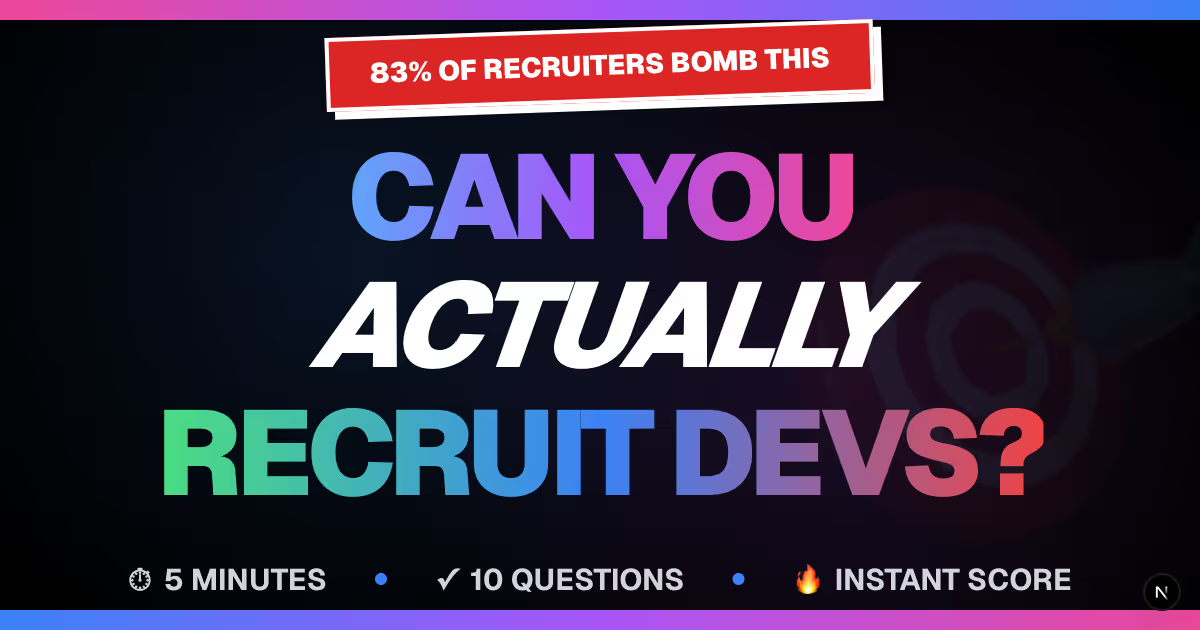


Learn how to attract top data science talent with effective job descriptions that clearly outline roles, responsibilities, and compensation.
When hiring data scientists, a well-crafted job description is your first step to attracting top talent. A clear, specific, and structured job post can set your company apart in a competitive market. Here’s how to do it right:
- Use Clear Job Titles: Avoid vague titles like "Data Guru." Stick to industry-standard roles like "Data Scientist" or "Machine Learning Engineer."
- Detail Responsibilities: Outline daily tasks with action verbs (e.g., "develop predictive models" or "present insights to teams") to give candidates a clear picture of the role.
- Separate Required vs. Preferred Skills: Focus on 3–5 essential skills (e.g., Python, machine learning) and list extras (e.g., AWS) as "nice-to-haves."
- Be Transparent About Pay and Benefits: Include a salary range, benefits like health insurance, and work setup details (e.g., remote, hybrid).
Tailor descriptions to specific data science roles (e.g., NLP Specialist, Data Analyst) and company size (startup, mid-size, enterprise). Avoid common mistakes like unrealistic skill requirements or unclear descriptions. A great job post doesn’t just list qualifications - it tells candidates why they should join your team.
Core Components of Data Scientist Job Descriptions
Crafting an effective data scientist job posting means clearly outlining what the role entails and who you're looking for. Let’s break down the key elements that make a job description stand out.
Writing Clear Job Titles
The job title is the first thing candidates see, and it plays a major role in attracting the right talent. When it comes to data science roles, being specific is far more effective than being overly creative. Titles like "Data Professional" or "Analytics Expert" are too vague and don’t give candidates a clear sense of the role.
Instead, use precise titles that reflect the actual responsibilities. For example:
- "Machine Learning Engineer" attracts candidates skilled in deploying models and handling technical engineering tasks.
- "Data Analyst" appeals to those focused on reporting and business intelligence.
- "Senior Data Scientist" signals a leadership role with broad analytical responsibilities.
Avoid using internal jargon or quirky titles that might confuse job seekers. Sticking to industry-standard titles improves visibility and makes it easier for candidates to find your posting.
Once the title grabs their attention, the next step is to outline what the role involves.
Writing Role Summaries and Daily Tasks
Start by explaining the role’s purpose and how it impacts the organization. Then, break down the day-to-day responsibilities in a way that’s easy to skim - bullet points work well here.
Be specific about what the candidate will deliver. Instead of generic phrases like "analyze data to support business decisions", say something like, "Develop predictive models to forecast customer churn and present insights to the marketing team on a monthly basis." Use action verbs like "develop", "implement", "collaborate", and "present" to help candidates picture themselves in the role.
Next, clarify the skills needed to succeed in the position.
Required vs. Preferred Skills
A common mistake in job postings is blending must-have qualifications with nice-to-have extras. This can either overwhelm candidates or lead to applications from people who aren’t a good fit. Clearly distinguishing between required and preferred skills helps set the right expectations.
-
Required skills should include the core competencies needed to perform the job. For data science roles, this often means:
- Proficiency in programming languages like Python, R, or SQL
- Knowledge of machine learning and statistical modeling
- Experience working with large or incomplete datasets
- A degree in Mathematics, Computer Science, Statistics, or a related field (or equivalent work experience)
-
Preferred skills are additional qualifications that enhance a candidate’s ability to contribute but aren’t deal-breakers. These might include:
- Familiarity with tools like Scala or Java
- Experience with distributed computing platforms such as Spark or AWS
- Strong communication or presentation skills
For example, a well-structured skills section might look like this:
- Required: BS in Mathematics, Computer Science, or a related field. 3+ years of professional experience in data science. Proficiency in Python, R, and SQL.
- Preferred: Experience with Scala and Java. Familiarity with data visualization tools.
Once you’ve outlined the skills, it’s time to talk about compensation and work conditions.
Salary, Benefits, and Work Location Details
Transparency around pay and work conditions is crucial. According to LinkedIn research, 82% of job seekers say seeing a salary range in a posting gives them a better impression of the company. Job ads that include salary ranges also attract over 30% more applicants.
When listing salaries, use realistic figures that align with the role’s responsibilities and seniority. For instance, the average base salary for a data scientist in 2025 is $126,554, though this may vary depending on experience and location. Avoid overly broad ranges, as they can create confusion.
Detailing benefits is equally important. Candidates care about more than just the paycheck - they also look at the overall compensation package. Include specifics about health insurance (mentioning the provider, if possible), retirement plans, paid time off, and any unique perks like tuition reimbursement or wellness programs.
Finally, be clear about the work location. Specify whether the role is remote, hybrid, or office-based, and define what that means. For example, if a hybrid role requires three days a week on-site, say so explicitly. Include details about working hours and flexibility, especially if the role involves cross-time-zone collaboration or non-standard schedules. Clear communication here avoids misunderstandings and helps attract candidates who align with your expectations.
Job Descriptions for Different Data Science Roles
Crafting job descriptions that align with the specific demands of various data science roles is key to attracting the right talent. By understanding the unique responsibilities and technical skills required for each position, you can set clear expectations and draw in candidates who are a perfect fit.
Types of Data Science Jobs
The field of data science encompasses a variety of specialized positions, each with distinct focus areas and technical expertise:
- Machine Learning Engineers focus on building and deploying predictive models. They work with tools like TensorFlow and PyTorch and combine software engineering skills with statistical know-how.
- Data Analysts interpret data to support decision-making. Their work involves creating reports, dashboards, and visualizations using tools like Tableau or Power BI, alongside SQL and statistical analysis.
- Business Intelligence Specialists act as a bridge between data and strategy. They design data warehouses, develop automated reporting systems, and help organizations understand performance metrics using platforms like Microsoft SQL Server, Oracle, or cloud-based tools.
- Research Scientists in data science push the boundaries of analysis by developing new algorithms and methodologies. Often with advanced degrees, they focus on experimental design, hypothesis testing, and academic research.
- NLP Specialists specialize in processing text data. They use techniques like Named Entity Recognition, Dependency Parsing, and Semantic Role Labeling, leveraging tools such as Elasticsearch and Apache Spark.
- Computer Vision Engineers work with image and video data. Their expertise includes convolutional neural networks and image processing libraries like OpenCV.
- Predictive Analytics Specialists focus on forecasting and optimization. They rely on time series analysis and statistical modeling to predict outcomes and drive strategies.
Role Comparison Table
Here’s a breakdown of key differences between data science roles to help you tailor job descriptions:
| Role | Primary Focus | Key Technical Skills | Typical Tools | Experience Level |
|---|---|---|---|---|
| Data Analyst | Reporting & insights | SQL, Excel, basic statistics | Tableau, Power BI, Python/R | 1-3 years |
| Data Scientist | Model building & analysis | Python/R, machine learning, statistics | Jupyter, scikit-learn, pandas | 2-5 years |
| Machine Learning Engineer | Model deployment & production | Python, software engineering, MLOps | TensorFlow, PyTorch, Docker, AWS | 3-7 years |
| NLP Specialist | Text & language processing | NLP techniques, deep learning | spaCy, NLTK, transformers, Elasticsearch | 18+ months NLP experience |
| Business Intelligence Specialist | Data warehousing & dashboards | SQL, ETL processes, data modeling | Power BI, Tableau, SQL Server | 2-4 years |
Writing Tailored Job Descriptions
When drafting job descriptions, specificity is key. Highlight the methodologies and tools candidates will use in their roles. For example:
- Predictive Analytics Roles: Detail responsibilities like creating forecasting models and optimization algorithms to drive strategies such as pricing.
- Machine Learning Roles: Emphasize applying machine learning techniques to practical challenges and the importance of statistical modeling expertise.
- NLP Specialist Roles: List specific techniques such as Named Entity Recognition, Dependency Parsing, Semantic Role Labeling, and Probabilistic String Matching to ensure candidates possess the required skills.
For positions involving cloud-based platforms, be explicit about preferred technologies. For instance, mention AWS tools like SageMaker and Redshift for cloud machine learning roles, or frameworks like PyTorch and TensorFlow for deep learning positions. This level of detail not only attracts qualified candidates but also helps them assess their suitability for the role.
Balancing Theory and Practice
Specialized roles in data science demand both theoretical knowledge and practical application. Seek candidates who can balance rigorous methodology with real-world implementation. This combination is essential for delivering results while maintaining a high standard of scientific accuracy.
Armed with a clear understanding of these roles, you’re ready to create job descriptions that meet the unique requirements of each position. This precision will help you attract top talent and set the stage for success.
Ready-to-Use Job Description Templates
These templates are crafted to help you create clear, concise job descriptions that attract top-tier data scientists. Each one includes essential sections while offering flexibility to reflect your company’s specific needs and culture, tailored for U.S. hiring practices.
Templates for Different Company Types
The size and type of your company can significantly influence how candidates perceive the role. Startups often offer dynamic, high-impact positions, while larger enterprises provide structured career paths and extensive resources.
Startup Template (1-50 employees):
Use energetic language to highlight growth and impact. In the "About [Company]" section, focus on the fast-paced environment, access to leadership, and the chance to take on varied responsibilities. Be transparent about your funding stage, as this adds credibility. Salaries may vary based on company size and complexity, so communicate openly about compensation expectations.
Mid-Size Company Template (51-500 employees):
Strike a balance between stability and growth. Mid-size companies often offer structured career paths while maintaining a degree of agility. Your company bio should emphasize mentorship opportunities, clear advancement paths, and established processes. Highlight perks like professional development budgets, conference opportunities, and comprehensive onboarding programs.
Enterprise Template (500+ employees):
Focus on stability, resources, and comprehensive benefits. Enterprises can often offer higher salaries due to their scale and complex data needs. Highlight access to vast datasets, advanced technology, and projects with global reach. Include details about retirement matching, health benefits, and professional development programs to appeal to candidates seeking long-term growth.
Next, let’s look at how these templates adapt to different work setups, helping you fine-tune your job descriptions even further.
Templates for Different Work Setups
Your work arrangement - remote, hybrid, or on-site - plays a crucial role in attracting candidates. Modern data science roles often offer various setups, so it’s essential to clearly communicate expectations and benefits in your job ads.
Remote Work Template:
"Mention office hours, remote working possibilities, and everything else you think makes your company interesting." - Toptal
Start with a remote-friendly introduction to appeal to candidates who value location flexibility. In the "Work Hours & Benefits" section, outline communication expectations, time zone requirements, and tools for virtual collaboration. Include perks like home office stipends, allowances for co-working spaces, and virtual onboarding processes. Address potential concerns by showcasing your experience with distributed teams and opportunities for remote career growth. If there’s occasional travel for meetings or events, make that clear.
Hybrid Work Template:
Be upfront about your hybrid work expectations. Specify in-office days, core collaboration hours, and flexibility for personal schedules. Highlight the balance between focused remote work and in-office collaboration.
In the benefits section, include both remote and in-office perks, such as commuter benefits, office amenities, and flexible scheduling for family needs. Provide details about parking, public transit access, and policies like hot-desking to help candidates visualize their work experience.
On-Site Template:
Emphasize the advantages of working on-site, such as access to cutting-edge hardware, specialized software, and secure data environments that aren’t available remotely.
"Highlighting benefits such as work-life balance, remote work options, professional development opportunities, health benefits, and other perks can make the job opening more attractive to potential candidates." - DataCamp
For on-site roles, focus on location-specific benefits like proximity to educational institutions for continued learning, local networking events, and tech meetups. Include practical details such as parking availability, public transportation options, and nearby amenities.
Legal Considerations for U.S. Templates
Ensure compliance with legal requirements to build trust with candidates. Add an equal opportunity employer statement and address state-specific salary transparency laws, particularly in states like California, Colorado, and New York, where salary ranges are mandatory in job postings. Include language about reasonable accommodations under the Americans with Disabilities Act and specify which states you can hire from for remote roles, as tax and legal restrictions may apply. For roles in regulated industries or government contracts, mention any necessary security clearance requirements.
These templates are a starting point you can adapt to fit your company’s culture and the specific data science role you’re hiring for. The goal is to clearly define expectations while showcasing what sets your opportunity apart in the competitive data science job market.
sbb-itb-d1e6221
Common Job Description Mistakes to Avoid
When crafting job descriptions, it’s easy to fall into traps that can scare off qualified candidates, especially in competitive fields like data science. Here’s how to avoid some of the most common missteps:
Unclear Role Descriptions
Using vague or overly creative titles like "Data Ninja" might sound catchy, but they don’t help candidates understand the role. Similarly, broad descriptions like "analyze data to drive business insights" or "work with stakeholders to solve problems" lack the specifics that make your opportunity stand out. Instead, be precise. Highlight the types of data the role will handle, the business challenges your team is addressing, and how the role contributes to the company’s goals.
Another common mistake is leaving out technical details. Candidates shouldn’t have to guess whether they’ll be building models from scratch, refining pipelines, or cleaning datasets. Be upfront about daily tasks, tools, and systems. This transparency helps candidates assess if the position aligns with their skills and aspirations.
Unrealistic Skill Requirements
Overloading the job description with an endless list of required skills or blending multiple roles into one can deter even the most qualified applicants. For example, requiring years of experience with technologies that are relatively new or asking for senior-level expertise in a mid-level role creates unrealistic expectations.
To attract the right talent, focus on 3–5 core skills essential for immediate success. List additional skills as "nice-to-haves" or areas where candidates can grow on the job. This approach not only broadens your candidate pool but also shows that your company values professional development.
Writing Developer-Friendly Job Posts
Technical professionals prefer straightforward, no-nonsense job descriptions. Skip the overly polished marketing language and focus on the technical details. For example, instead of saying "work with big data", specify data volumes, database technologies (like PostgreSQL or MongoDB), and processing tools (like Spark or Dask).
It’s also helpful to describe your development environment. Mention things like version control practices, code review processes, testing frameworks, and deployment methods. These details give candidates a clear picture of how your team operates day-to-day.
Finally, be transparent about compensation. Include competitive salary ranges in your job post - especially if your state mandates salary disclosures. Many candidates cross-check figures on platforms like Glassdoor and Levels.fyi, so make sure your offer aligns with the role’s requirements and expectations.
Conclusion: Writing Job Descriptions That Attract Top Data Scientists
Crafting effective job descriptions for data science roles is about finding the sweet spot between your company's needs and the aspirations of potential candidates. The best job posts strike a balance between technical accuracy and clear, engaging communication, giving candidates the information they need to decide if the role is the right fit.
Specificity is key. Instead of vague phrases like "analyze data", provide detailed insights into the datasets, tools, and business challenges involved. This level of precision not only draws in qualified applicants but also helps candidates assess their genuine interest and suitability for the role.
Another important factor is customization. A machine learning engineer at a fintech startup will require a very different skill set and face unique challenges compared to a data analyst in the healthcare sector. Tailoring your job descriptions to reflect these nuances ensures you're targeting the right talent for the right role.
While templates and examples can serve as a helpful starting point, refining your descriptions based on the quality of applications received is crucial. Pay attention to which posts resonate with candidates and adjust your approach accordingly.
Be realistic with your skill requirements and avoid vague language. Transparency around compensation, daily responsibilities, and growth opportunities fosters trust with potential hires. When candidates know exactly what to expect, they’re more likely to engage with your listing and see your company as a credible employer.
Tools like daily.dev Recruiter take these principles further by providing warm, double opt-in introductions to pre-qualified developers. This developer-first approach ensures your well-crafted job descriptions reach candidates who are already interested and ready to explore the right opportunities.
In today’s competitive market for data science talent, clear and thoughtful job descriptions can set your company apart. They show professionalism, respect for candidates' time, and a genuine interest in finding the right match. This clarity not only attracts top talent but also positions your organization as a forward-thinking leader in hiring for data science roles.
FAQs
How can I write a job description for a data scientist that attracts qualified candidates instead of just generating a high volume of applications?
To bring in the right candidates, start with a clear and detailed job description. Lay out the role's responsibilities, necessary skills, and qualifications in a way that matches your company's specific needs. Skip the jargon and vague terms - clarity is key to avoiding misunderstandings.
Make sure to showcase what sets your company apart. Share what makes this role appealing, whether it’s your team’s dynamic, exciting projects, or the tools and technologies candidates will get to work with. Be upfront about expectations, like major tasks, required tools, and potential growth opportunities. A well-thought-out job description not only helps candidates determine if they’re a fit but also catches the attention of top talent in the data science world.
What are some additional skills that can benefit a data scientist but aren't strictly required for the role?
While not mandatory, some skills can greatly boost a data scientist’s impact and adaptability. For instance, having hands-on experience with cloud platforms such as AWS, Azure, or Google Cloud can be a game-changer when it comes to handling massive datasets and deploying machine learning models efficiently. Another key strength is business acumen, which enables data scientists to align their projects with company objectives and effectively present insights to non-technical audiences. Lastly, data visualization skills using tools like Tableau, Power BI, or D3.js are invaluable for turning complex analyses into clear, actionable insights that teams can easily understand and apply.
How can I write job descriptions that clearly differentiate between roles like Machine Learning Engineer and Data Analyst?
When crafting job descriptions that make each role stand out, it's crucial to clearly define the responsibilities and expectations unique to each position. For instance, a Machine Learning Engineer might dedicate their time to designing and deploying predictive models, while a Data Analyst would focus more on interpreting data and presenting insights through visual reports.
Make sure to specify the skills and experience needed for each role. Highlight technical expertise such as programming languages like Python or SQL, and tools tailored to the job - TensorFlow for Machine Learning Engineers or Tableau for Data Analysts. Using precise, role-specific terminology ensures candidates can easily identify the position's focus and assess how their skills align with your requirements.
Related Blog Posts








